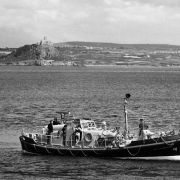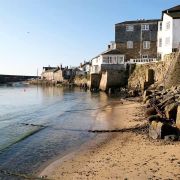Tucked away in the shelter of the western end of Mounts Bay is the archetypal Cornish fishing village of Mousehole. Once the home of poet and playwright Dylan Thomas, he described it as ‘the loveliest village in England’.
With all of Mousehole’s charms come a fair bit of history. The first definitive records of the village are from around 1267 when it appears to have been the most important fishing port in Mounts Bay. Back then it was known as Porth Enys, which translates as ‘port of the island’. This no doubt refers to St Clement’s Isle which lies a few hundred metres off the harbour. The islet was named after a hermit who lived here and from the 7th century was home to a small chapel, although this has since gone.
The first mention of Mousehole comes in 1283 which appears to predate the South Quay by over a hundred years. Possibly the oldest pier in Cornwall this shows how important the village was. As early as the 14th century pilchards were being exported to France from Mousehole and the fishing fleet dwarfed those of neighbours Newlyn and Penzance.
Why is Mousehole called Mousehole?
Before we go on there is one thing to clarify – how to pronounce Mousehole. On no account must this ever be pronounced as it is written! The mere mention of small furry rodents will be met with at best a smirk from anyone remotely local. The correct way to say Mousehole is ‘Mowz-ul’. However, this is not the correct way to pronounce the shop of this name in the village, which is obviously pronounced as it appears!
Whilst it can be agreed on about how to say Mousehole, the origins of the name are somewhat less clear. One possible source is the large sea cave just beyond the village where smugglers are once reputed to have stashed there contraband. Another possibility is the name is derived from the Cornish word ‘moeshayle’ which has something to do with rivers and maidens. A further suggestion is that it is taken from the appearance of the original diminutive harbour.
To be honest nobody knows, so just pick your favourite!
The Spanish Invasion
On the morning of the 23rd July 1595 four Spanish galleons appeared off the coast of Mousehole. Led by Carlos de Amesquita a raiding party of around 400 men armed with pikes and shot proceeded to ransack the village.
The Spaniards also bombarded Mousehole from the sea with fairly devastating effect. Surprisingly only three men were killed but virtually every house in the village was damaged to some extent with many burnt to the ground. The only building to escape damage belonged to Squire Jenkyn Keigwin who met an unfortunate death from a cannonball while defending it.
Now know as the Keigwin Arms this distinctive Tudor building, with its two granite pillars, is the oldest remaining building in Mousehole. Next to the entrance is a plaque commemorating the death of Squire Keigwin.
After destroying Mousehole the Spaniards went on to burn down Paul church and raise Newlyn to the ground.
The Tale of Tom Bawcock
Mousehole has long been well-known for its Christmas lights. From a giant robin and christmas pudding to a whale and sea monster in the harbour these festive lights are well worth seeing. But there is a story behind them, and that is the tale of Tom Bawcock.
The story goes that one Christmas, back in the 1500s, a terrible storm prevented the fishing fleet from setting sail. It blew for so long that the inhabitants of Mousehole were in danger of starving. It was at this point that a local fisherman by the name of Tom Bawcock decided to brave the storm.
He set out in his little boat accompanied by his cat 'Mowzer' and this is where things turn a little magical. For his cat was a singing cat who's dulcet tones soothed storm allowing Tom to catch seven different types of fish, and in sufficient quantities to save the village.
On the return to harbour the storm blew up again and the skies turned to black leaving Tom and Mowzer unable to find their way home. But the villagers came to their rescue by lining the cliffs each holding a lantern to guide the heroes home. If you look at the harbour lights you will notice the strings of lanterns running along the streets.
Every 23rd December the tale is celebrated as Tom Bawcock's eve where there is much revelry in the streets and a seven fish Starry Gazey pie is baked. For those of you who don't know this is a fish pie where the heads of the fish poke out through the crust, gazing at the stars.
Dolly Pentreath
Dorothy ‘Dolly’ Pentreath is recorded as being the last native speaker of the Cornish language. She died in 1777, and although a resident of Paul village (at the top of the hill) she spent much of her time in Mousehole, and in particular the Keigwin Arms where she enjoyed a pint and a pipe.
It is said that Dolly made her reputation by uttering a few words in Cornish if her palm was crossed with silver and the price was right. If not she would more than happily provide some colourful language free of charge!
These days Dolly is remembered by the monument to her set in the wall of Paul church. The stone was funded by a Prince Louis Lucien Bonepart, an antiquarian who was somewhat fascinated by the tale of Dolly Pentreath.
There is some argument as to whether Dolly was in fact the last speaker. William Bodenar, who is also buried in Paul churchyard died some years later and was apparently a Cornish speaker.
The Penlee Lifeboat
Unlike the story of Tom Bawcock, real life tales of the sea do not always end happily and this is painfully true of the Penlee Lifeboat, Solomon Browne.
The lifeboat used to launch from Penlee Point, just around the corner from Mousehole and so it did on the night of the 19th December 1981. A distress call had been sent out by the coaster Union Star which had been drifting with no engines in mountainous seas and storm force winds.
The coaster had initially refused a tow from a tug boat as this would have involved salvage rights. A Sea King helicopter was scrambled from RNAS Culdrose and attempted to lift the crew off the ship but the conditions made this impossible.
Eventually, as the Union Star drifted closer to the rocky coastline just west of Lamorna the only hope was the Penlee lifeboat. Crewed by eight men from Mousehole the lifeboat came so close to rescuing the ship’s crew, managing to get four off. But the conditions were horrendous, at points the lifeboat was thrown onto the deck of the ship.
Then, abruptly, the radio went silent. Nobody knows for sure what happened next but all hands were lost. The little village was devastated and over 40 years on there is still an air of sadness around Christmas time. To acknowledge the loss, on the anniversary of the tragic night the famous harbour lights are turned off.










